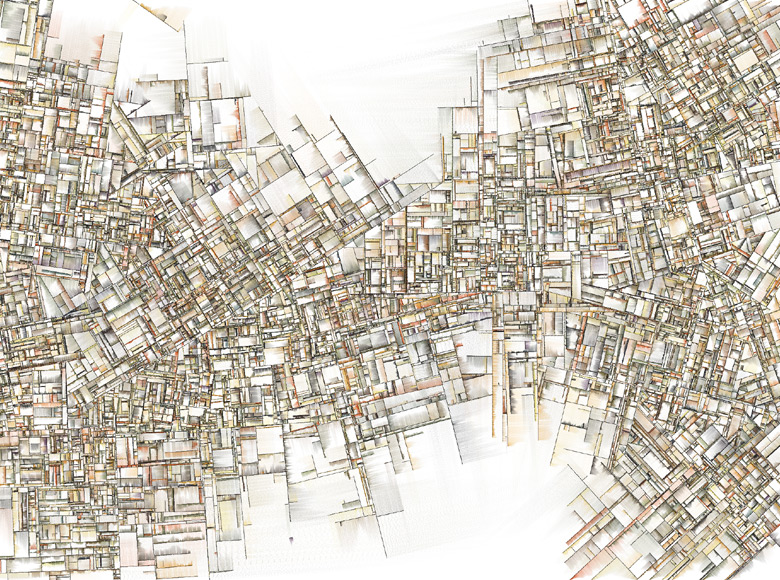 SUBSTRATE by Jared Tarbell, fractal generated urban pattern
SUBSTRATE by Jared Tarbell, fractal generated urban pattern“Two new types of urban structure are emerging in Germany, as the old system of a well balanced hierarchical order of towns typical for West-Germany is disappearing:
On the one hand we have, especially in East-Germany a “thinning-out” of the settlement system to such low densities, that the usual services of distribution, schooling and medical care cannot be financed any more and have to be substituted by a system of mobile services in combination with “centres” and “satellites”.
On the other hand we have, especially in the agglomerations, a transformation of the old System of “towns” and “suburbs” into a new “network-city”, which becomes more or less independent of the “mother-city”, developing forms of mutual co-operations. Here also the balanced hierarchy of services loses its meaning, and it is this new structure I want to talk about.”
-Thomas Sieverts
I start this tekst with a quote from Thomas Sieverts issuing a paradigme change in the way we understand the city. It ask for a new model for the city, a rethinking of the urban fabric. The definition city is no longer valid. What we see is that the city-meaning is moving towards a network of smaller independent clusters, interconnected and spacially growing. Proximity is replaced with accesibility.
“Sieverts calls this the Zwischenstadt, or “in-between city”, as it exists between old historical city centres and open countrysides, between place as a living space and the non-places of movement, between small local economic cycles and the dependency on the world market”
But can we define this network of clusters and the shrinking landscape in between as one whole, as the regional city. If we understand landscape and cityscape as one, can we then plan a cultural landscape called the regional city?
We see a growing tendency to think in regional terms, one of these is Ringbyen. But, where the big problem normally is politic and local administrations, where local authorities is competing in between, the ringbane project is a example of how the municipalities can work together to strenghen the regional profile, it is in this perspective we can start to consider Hjortekær, as a part of the regional city.
What is then the role of Hjortekær? When the city is seen as fractal clusters, what kind of concequence does that have on the site-specific cityscape?
What is then the role of Hjortekær? Can we define define the site-specific “home” in the fragmented urban landscape. And is it relevant? What does people define as their base? Is it a more subtle meaning than the 4 walls of a house or the road they live on? Is it a identity? What is the timescale of a "home" in a city of persistent transform?
http://www.goethe.de/kue/arc/dos/dos/sls/zup/en1488502.htm
SvarSletmore on Thomas Sieverts and the in-between city